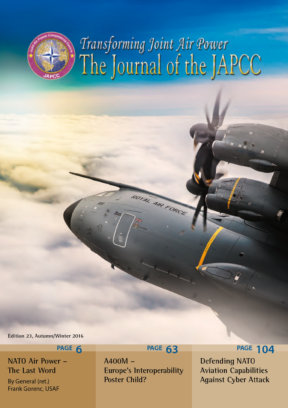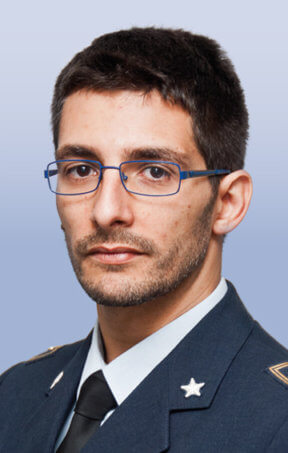Introduction
On 24 May 2016, the Assistant Director of the JAPCC, Air Commodore Madeleine Spit signed the Appointment Letter officially confirming the designation of the JAPCC as Department Head (DH) for ‘Space Support to NATO Operations’.1 For our Centre of Excellence, this means assuming a leading role with significant responsibilities in ensuring the provision of both individual and collective Education and Training (E&T) for NATO personnel in the field of ‘Space’. The assignment is a big achievement and the beginning of an exciting job with many tasks implied.
According to the NATO Education, Training, Exercises and Evaluation (ETEE) Policy MC 0458/3, the DH ‘supports Headquarters Supreme Allied Commander Transformation’s (SACT) responsibility for translating NATO E&T requirements into solutions for the individual and collective training spectrum’.2 In particular, the DH assembles a discipline-specific E&T program and is responsible for the coordination of the solutions. Obviously, this is just a general definition, which does not capture the particular duties of a DH to achieve effective and efficient E&T in NATO. This article will, therefore, provide a more detailed description of the current NATO ETEE policy and guidance, including the concept of Global Programming (GP) for E&T, and explain what this actually means for the work of a DH for Space.
E&T Principles in NATO
‘NATO E&T activities are core functions for preparing the NATO Command Structure (NCS) and NATO Force Structure (NFS) for current and future missions in accordance with the Alliance’s level of ambition (LOA).’3
Headquarters as well as units within NCS or NFS consist of many positions requiring dedicated, specialised personnel to effectively fulfil their duties. As a matter of principle, NATO expects the Nations to send fully qualified individuals to those jobs. The general obligations for prior national training are set by a framework of agreed standards,4 e.g. the Allied Command Operations (ACO) Force Standards (AFS). For individual positions within the NCS/NFS, specific job descriptions provide the definite requirements. During the first six months on their job, personnel should receive additional NATO training to lift them to the specific Depth of Knowledge (DoK) required for the position.
To achieve those E&T objectives, most Nations can rely on a broad variety of their own internal facilities. However, in order to provide NATO-specific E&T and to make standardized E&T available to all members, the Alliance operates seven NATO E&T Facilities (NETF), 23 Centres of Excellence (COE), and 29 Partnership Training Education Centres (PTEC).5
Global Programming – A New Management Approach for NATO E&T
The overall NATO E&T management is based on Global Programming (GP), which was established in 2012. This new approach came about as a result of national observations in 2006, which concluded the NATO E&T system was not working adequately. In 2009 an independent consultant listed 116 recommendations on NATO E&T, accentuating insufficient coordination and oversight, wasteful creation of unnecessary courses, progressive loss of the link between requirements and solutions, inefficient duplication of solutions and inadequate verification of the fulfilment of requirements. In particular, according to the report, the overall strategic picture and management framework was inadequate.6 GP is SACT’s response to achieve a collaborative, unified NATO effort for developing effective, efficient, and affordable E&T solutions. As laid down in detail in the Bi-Strategic Command Directive 072-002 (E&T Directive),7 GP introduces a holistic, structured and strictly requirements-based approach to NATO E&T management which clearly separates the responsibilities for both E&T providers and clients. In short, GP aims to convert broad political and military requirements into specific E&T requirements and find, or otherwise develop solutions to meet those requirements (Figure 1).
For ease of management, requirements are grouped and categorised into disciplines as per the Bi-SC List of Disciplines8 in Figure 2. The whole set of disciplines is meant to cover all NATO E&T requirements and is to be reviewed annually.
GP basically consists of three distinct but interrelated components: Governance Structure, Development Methodology, and Production Planning Process, which are further explained in the sections below.
First GP Component – the Governance Structure
Joint Force Trainer (JFT)
The HQ SACT Deputy Chief of Staff Joint Force Trainer (DCOS JFT) – on behalf of SACT – is responsible for the direction and coordination of the whole E&T spectrum. It sets the Governance Framework, updates the relevant documents and coordinates between all disciplines and within one discipline. For each discipline, JFT is supported by a Requirements Authority (RA) and a Department Head (DH) as illustrated in Figure 3.
Requirements Authority (RA)
For each discipline, the appointed RA represents the interests of the end user. For this reason, it is considered the specific operational authority and it is usually chosen within Allied Command Operations (ACO/SHAPE).
Within the specific discipline, the RA is to lead the identification of individual and collective E&T requirements by compiling, defining, and prioritizing these requirements within the range of available political-military guidance. Moreover, the RA provides inputs concerning changes to relevant NATO documents, doctrines, policy, and procedures. In particular, the RA ensures specific direction is contained with SACEURs Annual Guidance for ETEE (SAGE), as necessary.
The RA for Space is SHAPE ACOS J3.
Department Head (DH)
The DH is a volunteer organization with specific experience in a particular discipline and in E&T. It coordinates, under DCOS JFT guidance, identification and development of effective, efficient, and affordable E&T solutions for the requirements provided by the RA.
To this purpose, the DH is to collaborate and coordinate the definition as well as delivery of E&T solutions with designated facilities both inside and outside the military to include NATO’s own facilities and national providers.
The DH for Space is the JAPCC (C4ISR+Space Branch. Space Section).
Second GP Component – the Development Methodology
During the subsequent steps of the Development Methodology, the JFT, RA, and DH identify and refine E&T requirements resulting in the definition and delivery of individual and collective training solutions. Embedded within the Development Methodology are the means for sustaining E&T requirements and the associated solutions over time.
Strategic Training Plan (STP)
For each discipline, all identified E&T requirements deriving from tactical, operational, military-strategic, and political-strategic level tasks, are collected in a Strategic Training Plan (STP). This first step is completed by DCOS JFT, mainly supported by the RA.
Training Requirements Analysis (TRA)
Based on the STP, a Training Requirements Analysis (TRA) is conducted to capture all NATO E&T requirements, to compare them with available E&T existing solutions, and to detect gaps or overlaps. The results are published in a separate report. JFT, in close coordination with the RA and DH, is responsible for this step.
Training Needs Analysis (TNA)
E&T gaps highlighted in the TRA-Report are addressed by the DH through one or more TNA turns. Every TNA is conducted in close coordination with E&T providers and all relevant stakeholders. It applies the ‘System Approach to Training’ methodology, an iterative and interactive process to define, develop, and implement effective, efficient, and affordable solutions. The TNA process is started by the DH, but it requires a close coordination among JFT, DH, RA and the Education and Training Facilities.
Annual Discipline Conference (ADC)
At least once a year, an Annual Discipline Conference is organized and conducted by the DH, on behalf of HQ SACT/DCOS JFT, to review all E&T activities associated within a discipline. The objective of the ADC is to ensure E&T remains aligned with evolving needs, available technology and resources and to determine the way ahead. The results of this conference, including the plan for the follow-up actions, are published in the Discipline Alignment Plan.
Third GP Component – the Production Planning Process
The Production Planning Process is a recurring multi-disciplinary process, which helps planning and synchronizing the delivery of individual courses as well as collective training by involving all the relevant stakeholders in various meetings and conferences. The resulting programme of E&T solutions is available on two web-based training management systems: ‘e-ITEP’ (electronic Individual Training and Education Programme), for the individual courses, and ‘MTEP’ (Military Training and Exercise Programme), for the collective training opportunities. Both catalogues are accessible from Internet and are password protected.9
Department Head – Why the JAPCC?
Centres of Excellence (COEs) are international military organizations – nationally or multi-nationally funded – that offer recognised expertise and experience as well as independent research and analysis in support of the Alliance in a particular military domain. They have an active role in developing doctrine, identifying lessons learned, improving interoperability and capabilities, and testing and validating concepts through experimentation. Moreover, COEs participate in a multitude of NATO and multinational or national committees, working groups and forums, giving them the opportunity to develop and engage with a broad network of experts, which may reach into the E&T domain. Furthermore, in their significant role supporting the transformation of NATO, COEs have a close relation with SACT and a dedicated interest in providing expert advice in specific training matters. Independence of thought, networking capabilities, knowledge of the matter, and strong connection with HQ SACT are the characteristics that make COEs ideal candidates for the role of DH.
Within NATO, there is no specific COE for Space. However, the JAPCC, being NATO-accredited COE since 2005, holds a section of three dedicated Space experts inside its ‘Command, Control, Communications, Computers, Intelligence, Surveillance, Reconnaissance and Space’ (C4ISR+S) Branch. For NATO, therefore, it was a logical decision to appoint the JAPCC as the DH for Space Support to Operations.
Current Space E&T Situation
Currently there are very few opportunities in NATO for individual E&T in Space matters. The NATO School in Oberammergau (NSO) offers an ‘Introduction to Space Support to NATO Operations’ course twice a year. The only additional opportunity is delivered through the ‘JFAC Space Cell Course’ held at the French-hosted COE ‘Analysis and Simulation Centre for Air Operations’ (CASPOA). Moreover, the German Bundeswehr Command and Staff College offers a one-week basic course for the military use of Space capabilities, open for all NATO staff officers. By consequence, there is still a huge need for Space instruction, especially for advanced individual E&T. For this reason, a request for information has been recently issued to the allied nations, to explore the possibility to accredit more national E&T opportunities for NATO participants.
In addition, Collective Training and Exercises requires some improvement. In the last two years, the NATO Bi-SC Space Working Group have pushed hard to include more Space-related training into major NATO exercises. In particular, for Trident Juncture 2016, Space SMEs have taken part in the exercise scripting from the early stage, thus ensuring a stronger influence in the training objectives. The TRA Report shows there is still margin for further enhancements, mainly in the direction of a deeper integration of Space-related objectives; the process, however, seems on the right track.
Outlook
In summary, bringing E&T for the ‘Space Support to Operations’ discipline to a satisfactory level is a big challenge and there is still much to do. The latest TRA Report identified several E&T gaps, which the DH has to close in order to improve the individual and collective E&T spectrum.
In this situation, the Allies can contribute in broadening the variety of Space E&T solutions by opening their Space-related courses to NATO personnel. The DH at JAPCC welcomes course offerings within the wide spectrum of Space from all over NATO and partner nations, military schools and academia as well as civil institutes for exploring more E&T possibilities. For further details, please contact the authors of this article.












